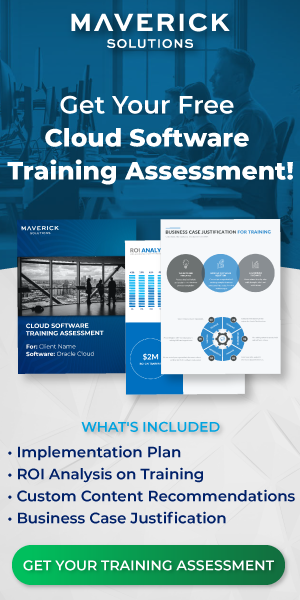Author: Jordan Edwards
Switching from your legacy system to Oracle Cloud software can seem like a daunting task, but with the right implementer and the right training partner, the move to Oracle Cloud can be smooth.
Since you’re reading this article, you must know the importance of training on new software. Training for Software as a Service is even more important than training on traditional, on-premises software. Training on Oracle Cloud can set your team up for success. It helps to drive user adoption and user proficiency which, in turn, allows your organization to hit peak ROI on your Oracle Cloud investment.
We’ve identified the five critical features you need to look for when choosing your team’s Oracle Cloud training provider.
#1 Training on Oracle Cloud needs to be constantly updated.
Okay, we’re starting with the most controversial feature. You’re probably wondering why training has to be updated. Let’s break down the common questions surrounding constant updates and the benefits to a training provider who updates training on Oracle Cloud for you and your team.
Does training on Oracle Cloud really have to be updated?
Yes, training on Oracle Cloud has to be maintained with each Oracle Cloud update. Your team likely decided to move to Oracle Cloud because Oracle keeps your team at the forefront of innovation by delivering quarterly updates to your software.
Could we buy go-live training from a training provider and then update the training internally?
Yes, you could, theoretically, maintain training internally. Let’s go over the difference between maintaining training internally and choosing a training provider.
Maintaining training internally
- Your organization has to set aside a budget for an internal training development team. Your organization will need to reassess the budget with each Oracle Cloud update.
- Your organization needs to procure a Subject Matter Expert for each Oracle Cloud application.
- As soon as the Oracle quarterly update goes live for your organization, your internal training development has to move quickly.
Choosing a training provider
- Your organization has to set aside a budget for a training provider. This will be a known and fixed expenditure.
- A training provider will have Subject Matter Experts for each Oracle Cloud application that will be included in the cost of your training.
- A great training provider should get the Oracle update before your organization does. This means your team will get up-to-date training before or right when your team gets the Oracle Cloud update.
Could training still be effective even if we don’t update it?
Yes and no, training will be effective for the first update or so, but training efficacy will quickly and steeply drop off after a few updates. Within one year, Oracle delivers four updates. Of those four updates, three of them may not have huge updates. Those three updates might include small updates, such as button color changes or icon changes. However, the fourth update could include huge changes to the User Interface. Those changes could include updates to the navigation within the UI or process changes, to name a few.
To keep user adoption high even after the software has gone through numerous updates, your training needs to be maintained quarterly. Yes, your team can maintain the training internally; however, maintaining training internally could be more expensive and stressful for your team. A training provider frees up your team to focus on important business initiatives.
Takeaway: Oracle Cloud software updates quarterly; your training needs to be updated quarterly. In other words, Software as a Service requires Training as a Service.

#2 Training on Oracle Cloud needs to be customizable.
Each organization with Oracle Cloud implements the software differently according to unique business practices and processes. Because of this, the training for Company A, B, and C needs training specific to their instance of Oracle Cloud. For example, user guides with step-by-step instructions covering how to update benefits plans need to be unique to each organization. Generic training that detail out-of-the box functionality and business processes could confuse your users.
Additionally, customized training allows your team to identify the problems your specific organization has and proactively address them. Once your team has determined which business processes or business challenges need to be addressed, your training provider can create the training documentation and tutorials to get ahead of the problem.
Takeaway: training is more efficient and effective when the training documents look like and training simulations function like the software.
#3 Training on Oracle Cloud needs to be interactive.
A good training provider offers various modes of learning, including an interactive mode. Your team should be able to practice complex business processes without affecting the live production environment. This empowers your team to be more confident in the Oracle Cloud User Interface and drives up user adoption. We’ve talked about the importance of custom training content, so let’s focus on why training should be interactive.
Most people learn best by doing. However, it does not make much business sense to let your whole organization practice filing expense reports, creating goals, or other processes in Oracle Cloud. If your team practiced in your live production environment, your IT team would need to devote hours cleaning the system up. Worse, you run the risk of breaking something in the system.
Takeaway: your team needs training that include interactive tutorials so they can practice complex business processes without affecting your live production environment.
#4 Training on Oracle Cloud needs to be on-demand.
Training should be flexible. The traditional way of holding instructor-led training sessions or one-on-one onboarding training is good, but it’s not enough.
The following list goes over some reasons live training sessions, such as instructor-led training sessions and one-on-one training, are not sufficient:
- Live training sessions are only available during scheduled times. This means if a user needs to ask a question after the training session, the instructor may not be available.
- Your users cannot learn at their own pace. The class moves together. People can get bored if the training session is not moving fast enough, or they can get left behind if the training session is moving too fast.
- Live training sessions do not allow for flexibility. Again, live training sessions are scheduled. If a team member gets the flu and cannot make it into work, they will have missed important training information. However, if your training is in the Cloud, they can catch up on the training when they get back to work.
- Your users cannot reference and review content as they need. The instructor may have left training documents behind after the live training session, but those training documents are meant to supplement the instructor. On-demand training is built so your users can have everything they need at the time of need.
Takeaway: training on Oracle Cloud should be available when your team needs it.
#5 Training on Oracle Cloud needs to be user friendly.
What use is training if your users don’t learn anything?
The most effective training on Oracle Cloud should be built with the user in mind. The following list goes over what it means for training to be user friendly:
- Training content should various modes of learning so that the users who learn by reading and the users who learn by doing get the same value from the training.
- Training documentation should not be written in technical language. Many of your team’s end users just need to learn how to submit their benefits package or complete their timecards; they don’t need to know how to configure time or run payroll.
- On-demand training should be searchable, and it should be easy to navigate.
Takeaway: the training should be built with users and learners in mind.
Conclusion
Oracle Cloud is a big investment of your organization’s time, resources, and effort. To maximize the ROI on your organization’s Oracle Cloud investment, your team needs the best training.
To recap, training on Oracle Cloud software needs to be:
- Constantly updated
- Customizable
- Interactive
- On-demand
- User friendly
Oracle Cloud Training by Maverick Solutions
The team at Maverick Solutions has been providing training on Oracle since 1999. We saw many companies move from on-premises software to Oracle Cloud software, and we noticed the training problem that was created as the Oracle Cloud software was updated. About six years ago, Maverick began to focus on on-demand training for Oracle Cloud. We have built the training content, we update the training content each quarter, and we customize your training so your team does not have to.
ENGAGE by Maverick, our Oracle Cloud training offering, has empowered companies in many sectors, including higher education, healthcare, government, and energy. We have helped our clients alleviate any onboarding problems. Our clients are able to assign our training content to their new hires with the trust that the training is always updated. Our training has also led to a decrease in support tickets on their Oracle Cloud software. Less support tickets allow your IT team to focus on new business initiatives.
If you have any questions about training and how training on Oracle Cloud can fit in Oracle Cloud implementation, set up a short call with our team of training experts!




